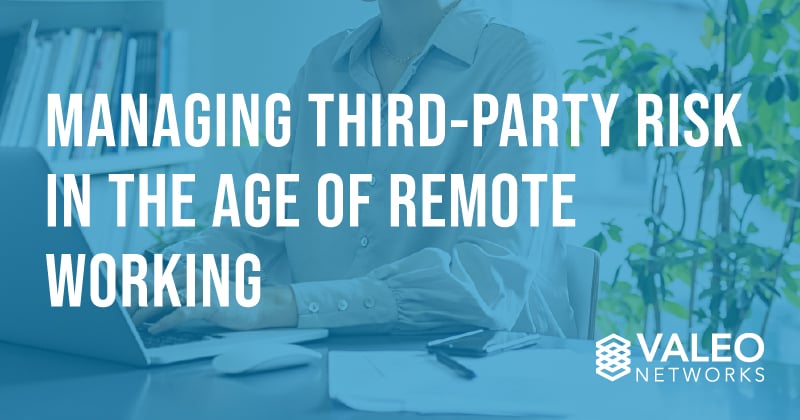Navigating Vendor Management Program Risk in the Age of Remote Working
Remote work was already a trend being adopted worldwide before the global COVID-19 pandemic necessitated its widespread acceptance. Now, the rapid...
3 min read
Travis Mack : Sep 8, 2020 4:00:00 AM
Modern cybersecurity threats evolve and become more difficult to deal with every day. In spite of the changing nature of threats, their two most common sources remain consistent — human error and third-parties. These weaknesses inherently compound when your business is engaged in the transfer of data with another organization. In other words, your vendor risk management policy needs to be rigorous enough to account for both sets of threats.
To help you mitigate these risks, we’ve identified five vendor risk assessment challenges with solutions for each one.
Conducting a cybersecurity risk analysis can be a major red flag or a green light when beginning a relationship with a new vendor.
Even in passing, their executive suite and any employees you deal with should have a clear understanding of their protocols and parameters for cybersecurity. This knowledge is magnified for those who will be in contact with your devices and data.
As noted, human error is the most prevalent form of cybersecurity weakness, and establishing congruent terms of acceptable safety is a critical step in heading off a potential attack.
For Third-Party Risk Management (TPRM), operational concerns demand a comprehensive understanding of your vendors.
Understanding the size of their organization, their business model, and their own cybersecurity concerns are paramount. Even large corporations such as Ticketmaster, British Airways, and Newegg found themselves prone to data breaches because of third-party vendors. This should be enough to compel your team to do its homework beyond an up-front analysis.
Consider reaching out to their CTO or IT team, depending on their organizational model. Have a list of questions about their procedures for both pre-empting risks and what their plan for a breach is.
In the cloud-based business world, most payments are processed digitally. This has created a global commerce boom while at the same time opening businesses up to data breaches via financial institutions.
It can be a bit of a puzzle to pinpoint how to best keep your vendors accountable for financial data — is it up to them or their banking institutions?

The answer is both, which is why having a thorough analysis and understanding of their policies is important. We’ve already brought up being familiar with their CTO, but it might also benefit you to contact whoever deals with their financial records, such as a CFO.
While the goal is not to create too much detective work for your team, having stringent requirements for third-party vendors will save you more time in the long run than the up-front investment.
Third-party interactions are at an all-time high for businesses. Cloud commerce continues to grow, along with business sectors that hadn’t existed until recently. Additionally, this environment encourages specialization and niche vendors, resulting in more outsourcing.
At the same time, there is an ever-multiplying number of cybersecurity threats. The public has become increasingly aware of the ramifications of these breaches (see Equifax, for example), so it is important that you look into any history of a third-party vendor to make sure they have not been repeatedly breached.
To check into this, make sure that there have not been class-action lawsuits or fines for non-compliance. Regulations and legislation such as the Health Insurance Portability and Accountability Act (HIPAA) or the California Consumer Privacy Act (CCPA) provide structural oversight to which businesses may have to show compliance.
Building off of reputational awareness is the need for a complete knowledge of a vendor’s compliance policies.
Just because an organization hasn’t been fined or sued for non-compliance doesn’t mean that their risk management approach is sufficient for your data. In fact, many major breaches were ‘first-time’ offenses officially but had stemmed from years of non-compliance or lack of policy in general.

In order to have a full-circuit of compliance between your organization and your vendors, you must understand what regulations affect them. Your team should learn about the vendors’ sector and the appropriate laws. Follow up by assessing whether they are in compliance with the basic laws surrounding their field.
Do not hesitate to break off early talks or terminate a relationship due to lack of compliance — this is a major factor in third-party cybersecurity breaches.
Cybersecurity attacks become exponentially more successful when targeting data transmitted between unprepared organizations. If your business falls prey to an attack stemming from third-party actions, you will be held just as accountable as the vendor.
In order to best mitigate these risks, you must have a plan for your vendors that is followed every time you begin negotiations to work together. If you don’t have an in-house CTO or IT team, it is crucial to consult with an outside expert to set up a full cybersecurity protocol.
Should you need assistance in third-party risk assessment, Valeo Networks is an industry leader in managed IT services, which includes creating and supporting cybersecurity strategic plans.
Please reach out — we’d love to help.


Remote work was already a trend being adopted worldwide before the global COVID-19 pandemic necessitated its widespread acceptance. Now, the rapid...

Proactive management is one of the most important factors in ensuring a productive vendor life cycle. While under contract with a third-party...

In the fast-paced digital business world, third-party vendors have a more profound impact on your organization than ever before. This can be positive...

With cutting-edge technology and quality customer service,
you’ll find everything you need to help your company soar
with Valeo Networks.
1006 Pathfinder Way
Rockledge, FL 32955
Business Hours:
M-F: 8AM-9PM
© 2025 Copyright Valeo Networks. All Rights Reserved.